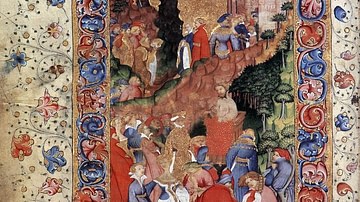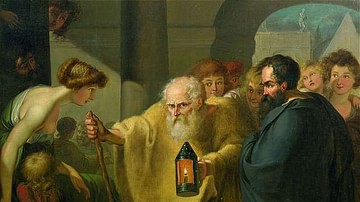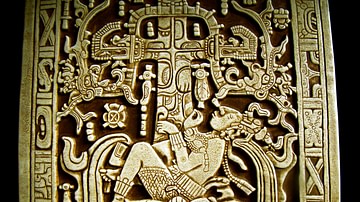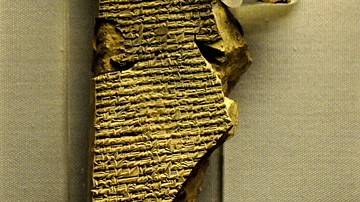The life and career of George Washington (1732-1799) were largely impacted by the French and Indian War (1754-1763). An officer of the Virginia Regiment, Washington's actions at the Battle of Fort Necessity and the Braddock Expedition helped escalate hostilities between Britain and France. His exploits in the war would help lead to his appointment as commander-in-chief of the Continental Army.

Background
In the early 1750s, tensions between the colonial empires of Great Britain and France were once again on the rise. The Ohio River Valley, though under the nominal control of the Six Nations of the Iroquois Confederacy, had been claimed by both empires; indeed, British and French traders had long been operating in the region, trying to establish commercial relations with local Native Americans. The British colony of Virginia, whose colonial charter asserted that its western border stretched all the way to the Pacific Ocean, was particularly interested in the Ohio Country. Virginia's economy was heavily reliant on the production of tobacco, which tended to exhaust the soil; to maintain economic growth Virginia had to acquire new, fertile lands for farming, of which the Ohio Country had in abundance. As early as 1745, Virginia's House of Burgesses began issuing land grants in the Ohio Country to land speculation companies, including the Ohio Company, which represented the financial interests of prominent Virginian investors. This unnerved the French, who wanted control of the Ohio Country both to deny the westward expansion of the British colonies and to maintain a connection between their own colonies of New France (Canada) and Louisiana.
In response to Virginia's encroachments into the territory, the French constructed three forts at the forks of the Ohio River. To Lieutenant Governor Robert Dinwiddie of Virginia, this was an unacceptable provocation; Dinwiddie was an investor in the Ohio Company, giving him a personal as well as a political incentive to want the French out of the Ohio territory as soon as possible. In 1753, he decided to send an envoy to demand that the French remove themselves from the Ohio. The man Dinwiddie decided to send for this crucial diplomatic mission may not have been the obvious choice – George Washington, a recently commissioned major in the Virginia militia, was only 21 years old, with little formal education and no knowledge of the French language. But what he lacked in experience, he made up for in ambition; Washington was hoping that a successful mission would advance his budding military career and earn him a commission in the regular army. Washington also had a connection to the Ohio Company – his recently deceased half-brother, Lawrence, was one of the first investors – which was likely another reason Dinwiddie chose him. On 1 November 1753, Washington left Virginia's capital of Williamsburg bearing a letter from the governor. It was a mission that would change his life and shape the history of North America.
First Expedition
Shortly after he set out on his journey, Major Washington was joined by two men: Christopher Gist, an experienced frontiersman and an Ohio Company agent, was to be his guide, while Jacob Van Braam, a French-speaking friend of the Washington family, would act as translator. The trio made their way to Logstown, a large Native American settlement 15 miles (24 km) downstream of the forks of the Ohio River. Logstown was populated by Mingos, Shawnees, and Delawares, clients of the Iroquois, and was overseen by the adopted Seneca chief Tanacharison, known to the Virginians as the 'Half-King'. Tanacharison hated the French, who he claimed had killed his father; more recently, the Half-King had been treated rudely by a French commander after having requested that the French stay out of Iroquois territory. After exchanging gifts, the Half-King offered to accompany the Virginians the rest of the way to the Ohio Forks. During this journey, Tanacharison bestowed upon Washington the nickname of Conotocaurius, or 'Devourer of Villages', in reference to Washington's great-grandfather, who had helped expel the Native Americans from their lands in Virginia.
On 4 December, the small company reached the nearest French fort at Venango. The fort's commander, Captain Philippe-Thomas de Joncaire, greeted them cordially and invited them to dinner. When Washington tried to hand him the governor's letter, Joncaire replied that he did not have the authority to receive it and told Washington to take it to his own commanding officer at Fort LeBoeuf. During the dinner, Joncaire's French officers had a little too much to drink and began boasting to Washington about how they intended to take control of the entire Ohio River and prevent the settlement of Englishmen there, validating Dinwiddie's concerns. The next morning, Washington's party set out for Fort LeBoeuf, arriving during a snowstorm on 11 December. Again, they were greeted warmly by the regional commander, Captain Jacques Legardeur de Saint-Pierre, and again, Washington was told that his letter would not be accepted here – he would have to take it to the governor of Canada at Quebec. Upon hearing this, Washington lost his patience and declared that he would not leave until he had an answer.
During his stay at Fort LeBoeuf, Washington noted that the French had assembled hundreds of canoes and bateaux on the riverbank, hinting that they meant to construct a fourth fort; this would become Fort Duquesne at the confluence of the Allegheny and Monongahela rivers where Pittsburgh stands today. This itself was enough of an answer to take back to Dinwiddie. On 16 December, Washington departed from Fort LeBoeuf somewhat concerned by the fact that Tanacharison and the other natives had stayed behind to indulge in food and alcohol offered them by the French. Washington had also come to realize that Tanacharison had less authority over the Ohio Indians than he had initially thought, making him wonder how many Native Americans would aid the British should a war break out. The return trip from the Ohio Forks was perilous. Washington and Gist, traveling overland, were attacked by a Native American guide they had hired; after Gist overpowered the man, Washington decided to let him go. On 29 December, the pair were crossing the Alleghany River on a raft when Washington fell overboard – he may have drowned had Gist not pulled him from the freezing water. Finally, on 16 January 1754, Washington returned to Williamsburg to report what he had seen.

Jumonville Glen
After listening to Washington's report, Dinwiddie ordered that a British fort be constructed on the forks of the Monongahela River. To see this through, he raised a military unit called the Virginia Regiment, led by Colonel Joseph Fry. Washington was commissioned as a lieutenant colonel in the regiment and was instructed to raise a company to aid in the fort's construction. By April 1754, he had scraped together 159 men, most of whom were, in the words of historian Fred Anderson, "paupers and vagabonds coerced into service" who were "poorly clad, poorly shod, poorly supplied, and as yet wholly untrained" (45). In late April, Washington led this scrappy force toward the western frontier. Over a month later, on 24 May, they arrived at a boggy grassland called Great Meadows (in modern Fayette County, Pennsylvania) where Washington ordered they make camp as they awaited fresh orders.
On 27 May, Christopher Gist rode into Washington's camp to report that he had spotted a party of French soldiers near his trading post by the Monongahela; by his estimation, the French could be no more than 5 miles (8 km) away from Great Meadows. Startled, Washington dispatched 75 men to go with Gist and find them. That evening, a Mingo warrior arrived with a message from Tanacharison, stating that he had located the French camp. Washington immediately set out with 40 men to rendezvous with the Half-King, who he found in command of twelve warriors, two of whom were only boys. After a brief discussion, they decided to ambush the French camp. Early in the morning of 28 May 1754, Tanacharison led Washington to a deep glen surrounded by rock; the French camped at the bottom were only just emerging from their tents for breakfast. What happened next remains unclear to this day; Washington would later claim that the French noticed his men surrounding their camp and opened fire, while the French accused the English of firing at them without warning. Whatever the case, the battle was over as quickly as it began. When the smoke cleared, one Virginian was dead and three wounded, and fourteen French lay dead or wounded.
The French commander, 35-year-old ensign Joseph Coulon de Villiers de Jumonville, was among the wounded. With the help of a translator, he began to explain the purpose of his expedition; much like Washington the year before, he had been sent to demand that the British stop their construction of the fort on the Monongahela. No sooner had Jumonville finished his explanation than Tanacharison stepped over him and said in French: "Thou art not yet dead, my father" (Anderson, 47). The Half-King then split open the French officer's skull with his hatchet. His warriors took this as a signal to begin killing the rest of the French wounded, scalping them and stripping them of their clothes. Historian Fred Anderson claims that Tanacharison committed this crime for a calculated political purpose – his killing of Jumonville marked a point of no return, in which his Mingo people and the English were bound together by the spilling of French blood.
Fort Necessity
Shaken by the massacre at Jumonville Glen, Washington returned to Great Meadows, taking with him the 21 French-Canadians who had been taken prisoner. Hurriedly, his men began construction on a fort – Fort Necessity – as 200 more men joined them from Virginia, carrying light artillery. Washington also learned that he had been promoted to full colonel and was now in command of the Virginia Regiment – Colonel Fry had died after a fall from his horse. In mid-June, a company of British regulars arrived from South Carolina, while Tanacharison also moved his camp to Great Meadows. The Half-King initially assured Washington of Native American support; but, upon realizing that the crudely built Fort Necessity would not withstand a French assault, Tanacharison and his followers abandoned the British camp.
At 11 a.m. on 3 July 1754, the French finally arrived to take their revenge. There were 700 of them – more than double Washington's number – and they managed to surround Fort Necessity. It had been raining all day, and the British rushed into trenches that were filled with rainwater as the French began their bombardment from the surrounding hills. For the next eight hours, the French kept up this "galling fire" from "every little rising, tree, stump, stone, and bush" (Freeman, 60). The French intentionally shot the horses and cattle in the fort, to deprive the British of transportation and meat. At 8 p.m., the French broke off the attack and requested a parley. Washington, who had already lost a third of his men and was having difficulty finding dry powder, accepted, and sent his translator Jacob Van Braam over to negotiate terms of surrender.

Van Braam returned with the terms written in bad handwriting on a rain-soaked piece of paper; as dark settled, the words were especially difficult to make out. Van Braam explained that the French had no room for prisoners at Fort Duquesne and were therefore content to allow the British to return to Virginia with the honors of war, meaning that they could keep their arms and colors; in exchange, Washington only had to sign articles of capitulation, which stipulated that the prisoners taken from Jumonville Glen must be returned, that the Virginians must promise not to return to the Ohio River for at least a year, and that two officers be left behind as hostages to ensure the Virginians' goodwill. These were much better terms than Washington had expected, and he eagerly signed. It was not until much later that he realized that by signing the articles, he had inadvertently admitted to 'assassinating' Jumonville; in the confusion of the moment, Van Braam had mistranslated that clause. The assassination of a diplomatic envoy, which the French claimed that Jumonville had been, was an act of war; Washington's admittance to the crime escalated the conflict between France and Britain that would eventually blossom into a global conflict, the Seven Years' War. For now, Washington could do little else than march out of Fort Necessity and return to Virginia.
Braddock's Expedition
In February 1755, Brigadier General Edward Braddock landed in Hampton, Virginia, with two regiments of British regulars. Braddock was instructed to lead a campaign into the Ohio Country, capture Fort Duquesne, and dislodge the French once and for all. Washington, determined to finish what he had started, accepted an offer to serve as one of Braddock's aides-de-camp and traveled to Fort Cumberland, Maryland, where the expedition was gathering. Tanacharison had died the previous October, but a small band of Ohio Indians joined the expedition, led by the Half-King's successor, Scarouady. After months of preparation, the army finally left Fort Cumberland on 29 May, marching at a glacial pace along the road that Washington's Virginia Regiment had cut the year before. To increase speed, Braddock split the army into two divisions; a 'flying column' of 1,200 handpicked men led the advance, followed by the supply column and the wagon train. Before long, the 'flying column' was more than 60 miles (96 km) ahead of the supply column.
Washington came down with a bad case of dysentery and fell behind. He did not rejoin the column until 8 July, at which point the army was approaching the Monongahela River. The next afternoon, the expedition successfully crossed the river only 10 miles (16 km) south of Fort Duquesne without incident. With their objective nearly in sight, 300 men under Lt. Colonel Thomas Gage were sent forward in an advance party, against the advice of Washington. Unbeknownst to the British, the commander of Fort Duquesne had dispatched 900 men – including 637 Indigenous allies – to intercept the invading British. As Gage's advance party moved through the woods, it came under fire from the French and Indians who were hiding among the trees. Gage's men retreated in disorder, causing more confusion when they collided with Braddock and the main body, which had still been advancing up the road. The British scrambled to mount a defense, firing blindly into the woods at an enemy they could not see, all the while making excellent targets for the French and Indian marksmen.

Washington rode beside his commander, trying to rally the troops as bullets whizzed around him. Two of his horses were killed out from under him, and a bullet passed through his hat, but the Virginian colonel remained unscathed. General Braddock was not so lucky, taking a bullet in the back that knocked him from his horse. Shortly thereafter, the British broke and ran, spending the next two days in a panicked retreat through the wilderness. Braddock was carried in an ammunition cart, lingering in agony for several days before succumbing to his wounds; Washington arranged his burial, ensuring that there was no trace of the grave so that the pursuing enemy could not defile the body. By the time the flying column made it back to the supply column, 456 of Braddock's men had been killed and 422 wounded.
Forbes Campaign
After the catastrophe at the Battle of the Monongahela (also known as Braddock's Defeat), Washington resumed his role as commander of the Virginia Regiment. He spent the next two years enforcing military discipline, reorganizing supply lines, and even designing regimental uniforms; before long, the Virginia Regiment was one of the best colonial military units. Washington also oversaw the defense of Virginia's frontier, a challenging task; French and Indigenous raiding parties often made incursions into Virginia, fighting several skirmishes with Washington's men. During this time, Washington still sought a commission in the regular army and looked for a chance to join another campaign, hoping it would be more successful than Braddock's.
He would get his chance in 1758 when Brigadier General John Forbes was tasked with the capture of Fort Duquesne. Washington and the Virginia Regiment were among the 6,000 men of the Forbes Expedition, marching along a new road Forbes had cut through Pennsylvania, rather than using Braddock's old road. As the expedition neared Fort Duquesne, the French decided to abandon the fort rather than make a stand, blowing up the magazines before they left. On 24 November 1758, Washington led the advance party to the smoldering remains of Fort Duquesne; the expedition had succeeded without a shot having been fired. Despite the expedition's success, it became clear that Washington would still not be commissioned in the regular army.
Disappointed, he returned to Williamsburg at the end of the year and resigned from the Virginia militia. The next year, he married the widowed Martha Dandridge Custis and stood for election to the House of Burgesses, content to leave his military life behind him. At this time, the British had gained control of the Ohio River Valley, and the broader French and Indian War had swung in their favor; Britain would ultimately win the war, gaining possession of most of the French colonial territory in North America. Fearing further conflict with Native Americans, Britain forbade the colonists from settling in the newly acquired Ohio territory in the Royal Proclamation of 1763. This outraged many colonists, including Washington, who had fought and bled for the territory. The proclamation was one of the first grievances that set Washington on the path of picking up his sword once again, this time as commander-in-chief of the Continental Army during the American Revolutionary War.








